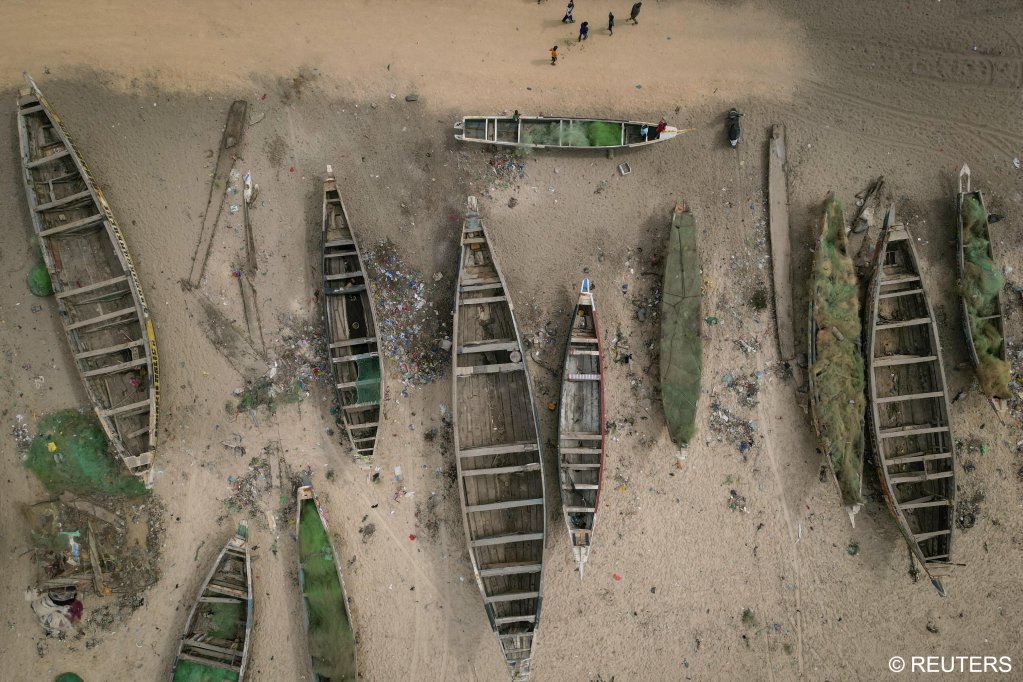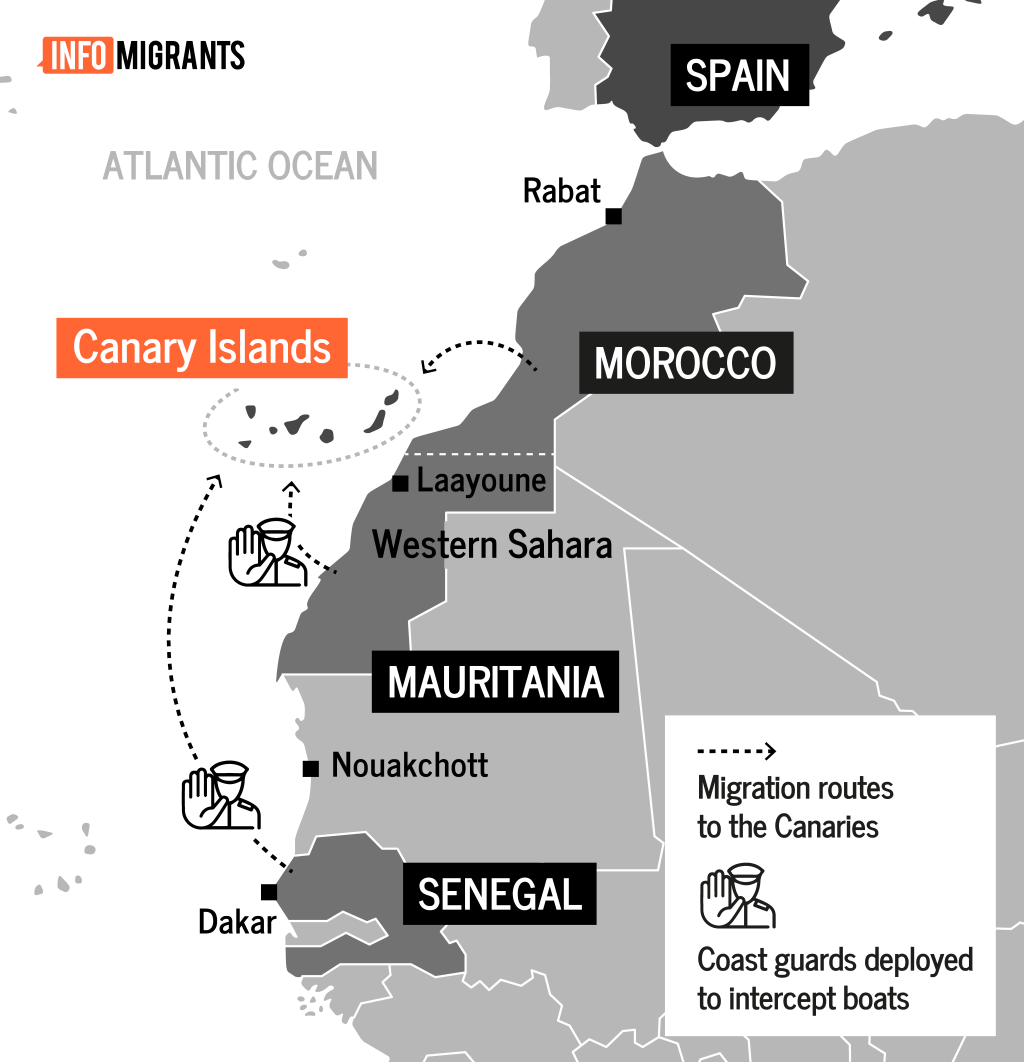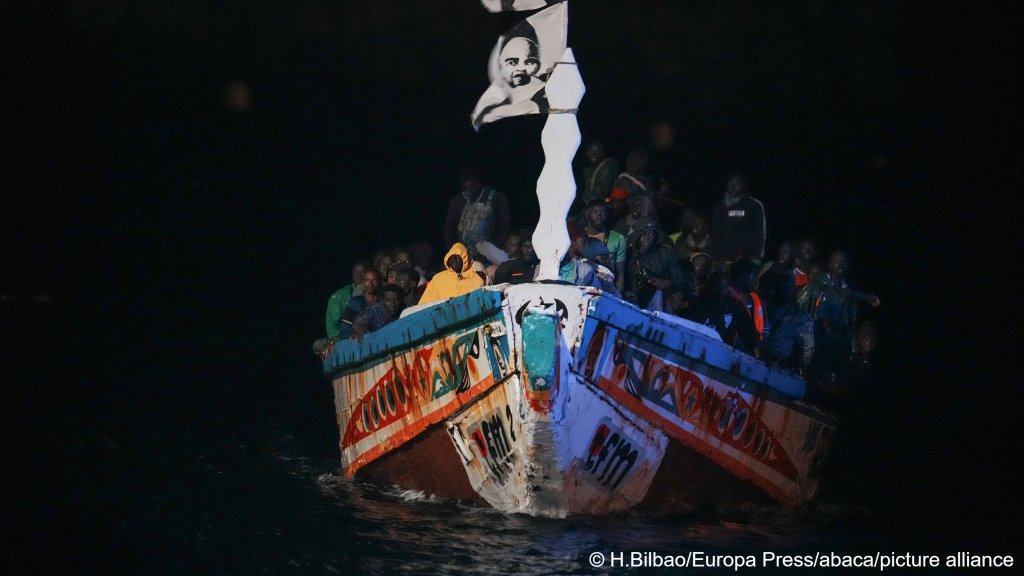Migration from West Africa to Europe is increasingly shaped by a web of intertwined political, economic, and climate-related factors. As conditions in the region continue to deteriorate, Mauritania emerges as a crucial launchpad for migrants aiming for Europe. InfoMigrants takes a look at some of the push factors driving people to take one of the deadliest migration routes in the world – the Atlantic route.
Political upheaval and economic turmoil in West Africa could push scores of migrants to travel from launchpad Mauritania to Spain's Canary Islands on unseaworthy vessels this summer season, migration experts predict.
Last week, a luxury cruise ship came to the aid of 68 migrants who were attempting to reach the Spanish Canary Islands aboard a fishing boat from the coast of Mauritania. They had become stranded in rough seas, and at least six individuals lost their lives during the tragedy.
In April, fishermen off the Brazilian coast of Para found a boat adrift carrying the bodies of nine people. Brazilian officials said the victims were migrants from Mali and Mauritania and that the boat had departed the latter country after January 17.
According to Spain’s interior ministry, this year has witnessed a fivefold increase in individuals attempting the journey from the northwest coast of Africa to the EU, primarily departing from Mauritania.
Meanwhile, there was a "significant drop" in irregular departures from Senegal and the Gambia in the first five months of 2024, according to a report from the migrant-focused NGO Caminando Fronteras.
The report did not specify the reasons for the change in migration routes, but several factors may be contributing. These include developments in Senegal and the Gambia, increased crackdowns on migrants, and enhanced border and maritime controls along the Mediterranean route and at the Spanish enclaves of Melilla and Ceuta. These measures may be diverting migration traffic through Mauritania, a country with about 90% of its territory located within the Sahara Desert.

Canary Islands
In recent years, the Canary Islands have emerged as the primary destination for undocumented migrants from the African continent entering Spain in search of a better life, despite the Atlantic being one of the deadliest irregular migration routes.
The Atlantic route is fraught with strong winds and currents. Boats veering off course can drift for months, ending up in distant locations where migrants can perish from dehydration and malnutrition.
The Interior Ministry of Spain reported that 55,618 migrants arrived by boat last year, with the majority reaching the Canary Islands, nearly doubling the previous year's figures. As of this year, over 23,000 migrants have already arrived, according to the ministry.
According to Caminando Fronteras, 4,808 people died on the Atlantic voyage to the Canaries after departing from Morocco, Mauritania, Senegal and Gambia, between January 1 and May 31, making it the deadliest route between Africa and Spain, with 95% of migrant deaths, according to the group.
Also read: 36 days at sea: A tale of death and survival on the Atlantic Ocean

Driving factors
People in West Africa are motivated to seek entry into Europe due to a combination of factors including limited job opportunities, the promise of a more stable life, the effects of climate change and increasing political instability.
According to migration expert and journalist Txema Santana, there were the political and economic ingredients of a "perfect storm" in West Africa that would likely see more mass arrivals to the Canaries in the upcoming summer and autumn seasons.
Also read: Senegal: More than 600 migrants intercepted in three days
Political factors
Political instability across West Africa is a driving force of migration. Conflict and violence disrupt daily life and pose significant threats to personal safety.
Countries like Mali, Nigeria, and Burkina Faso are grappling with insurgencies and terror groups, which have led to large-scale displacement of populations.
During the July 2023 coup, the military in Niger overthrew President Mohamed Bazoum, exacerbating security concerns in a country already dealing with extremist violence.
Sahel countries like Mali, Niger, and Burkina Faso continue to face severe security threats from Islamist militant groups such as Al-Qaeda in the Islamic Maghreb (AQIM) and Islamic State in the Greater Sahara (ISGS)/ Sahel Provence. These insurgencies have led to widespread violence, displacement, and humanitarian crises.
According to the International Organization for Migration (IOM), more than 2 million people have been internally displaced in the Lake Chad Basin due to Boko Haram-related violence. Northern Nigeria continues to be plagued by attacks from Boko Haram and its splinter group, Islamic State West Africa Province (ISWAP).
Governance issues such as corruption, lack of effective law enforcement and poor public services are also pushing people to leave.
According to the UN refugee agency, UNHCR, political repression and lack of civil liberties in countries like Guinea and Côte d'Ivoire are also forcing many to flee to safer regions.

Economic factors
Economic hardship and the inability to sustain livelihoods are other critical factors pushing people to migrate and seek better prospects in Europe. Economic policies and structural barriers such as inadequate infrastructure and limited access to education and healthcare services exacerbate these conditions.
West Africa faces high levels of unemployment and underemployment, particularly among young people, according to the World Bank. Youth unemployment in the region averages around 30%, with some countries experiencing even higher rates, the World Bank reported.
In addition, approximately 41% of the population in West Africa lives below the international poverty line of $2.15 per day. This translates to approximately 133 million people out of the region’s estimated 324 million population living in extreme poverty, according to figures from the World Bank.
Also read: Tales from the Border (1/8): Senegal -- Crossing the vast Atlantic Ocean
Climate factors
Climate change and displacement are increasingly interconnected, the UNHCHR has declared, noting that climate change such as extreme weather events is increasingly recognized as a significant driver of migration in West Africa. Climate change is disrupting livelihoods and making it more difficult for displaced people to become self-sufficient, according to the UN refugee agency.
Some climate change experts cite a lack of empirical evidence and political motivation to support the claim that climate change will give rise to more international migration into Europe. However, low-income and marginalized communities are most vulnerable to climate impacts because they don't have the means to mobilize and leave affected areas, and are at risk of becoming displaced. This creates what is known as "trapped populations," according to the United Nations Office for Disaster Risk Reduction (UNDRR).
West Africa is vulnerable to the impacts of climate change, which include erratic rainfall, severe droughts, and flooding. These conditions are devastating the region's agriculture – the primary livelihood for many inhabitants. The IOM reports that in the Sahel, recurrent droughts have led to significant crop failures and livestock losses, pushing people to migrate in search of more stable living conditions.
Senegal's economy is heavily reliant on agriculture and employs a large percentage of the population. But, the sector is highly vulnerable to climatic changes and market fluctuations, leading to economic instability for many families, according to IOM.
Additionally, rising sea levels and coastal erosion could threaten the livelihoods of those living by the sea, forcing some to move inland or to other countries. In the Senegalese town of Saint-Louis, severe coastal erosion and frequent flooding have displaced thousands of residents. The UN estimates that nearly 150,000 people in this region are at risk of displacement by 2050 due to these conditions.

EU partners with Mauritania to curb irregular migration
In February, the European Union and Mauritania signed a 210 million euro (225 million dollar) deal aimed at deterring migrant boats and cracking down on people smuggling, following EU Commission President Ursula von der Leyen's visit to the North African country.
In March, the EU announced its new partnership with Mauritania in enhancing cooperation on migration. EU Commissioner for Home Affairs, Ylva Johansson, and Mauritanian Minister of Interior and Decentralisation, Mohamed Ahmed Ould Mohamed Lemine, signed a Joint Declaration to officially launch the EU-Mauritania migration partnership.
The declaration was signed during a visit by Commissioner Johansson to Mauritania's capital, Nouakchott. She was accompanied by Spanish Minister of the Interior, Fernando Grande-Marlaska, and Belgium's State Secretary for Asylum and Migration, Nicole de Moor.
Europe must strengthen ties with transit spot Mauritania, UNHCR envoy says
The UNHCR's special envoy for the western and central Mediterranean, Vincent Cochetel, said governments must do more to provide an alternative to irregular migration. He told Deutsche Welle that Europe could strengthen ties with Mauritania, as this is where many irregular migrants transit through.
"They (Mauritania) are hosting on their territory about 150,000 refugees and so they already face quite a lot of challenges with the neighboring countries and other crises in the Sahel region," he said. The vast majority of Mauritania's refugees come from neighboring Mali.
"The majority of the refugees don't want to move, but Mauritania has become also a route now for migrants coming from other Western African countries who try to reach the Canary Islands through this route."
Cochetel said that Europe must be prepared for future conflicts that could spur more irregular migration, and not take a hands-off approach to humanitarian crises.
"You know, Sudan is only one country away from Europe, the same way that in 2015 Syria was only one country away from Europe," Cochetel said.
Is Mauritania really a new up and coming migration launchpad?
The EU-Mauritania deal and Europe's growing anti-migrant sentiments and border controls have drawn more attention to this particular migration route – but Mauritania as an irregular migratory launchpad to the continent is nothing new.
Historically, Mauritania’s role in the migration flow has been influenced by its strategic location and the broader migration dynamics in West Africa. The country has been a transit point for migrants from sub-Saharan Africa and other West African countries aiming to reach Europe, particularly via the Canaries due to the archipelago's proximity.
In 2014, the IOM had also noted a surge in the number of migrants arriving in the Canary Islands from Mauritania. In 2018, meanwhile, migrants diverted through Mauritania due to intensified migrant crackdowns in Morocco. In November 2020, a boat headed to the Canary Islands carrying around 140 migrants from North Africa including Mauritania capsized. In 2020 and 2021, the Canary Islands experienced significant numbers of migrant arrivals, with many coming from Mauritania.
Since 2014, the IOM's Missing Migrants Project has recorded more than 4,310 deaths and disappearances on the Atlantic route to the Canaries. The year 2021 marked the deadliest on record thus far, with 1,126 reported dead or missing.
